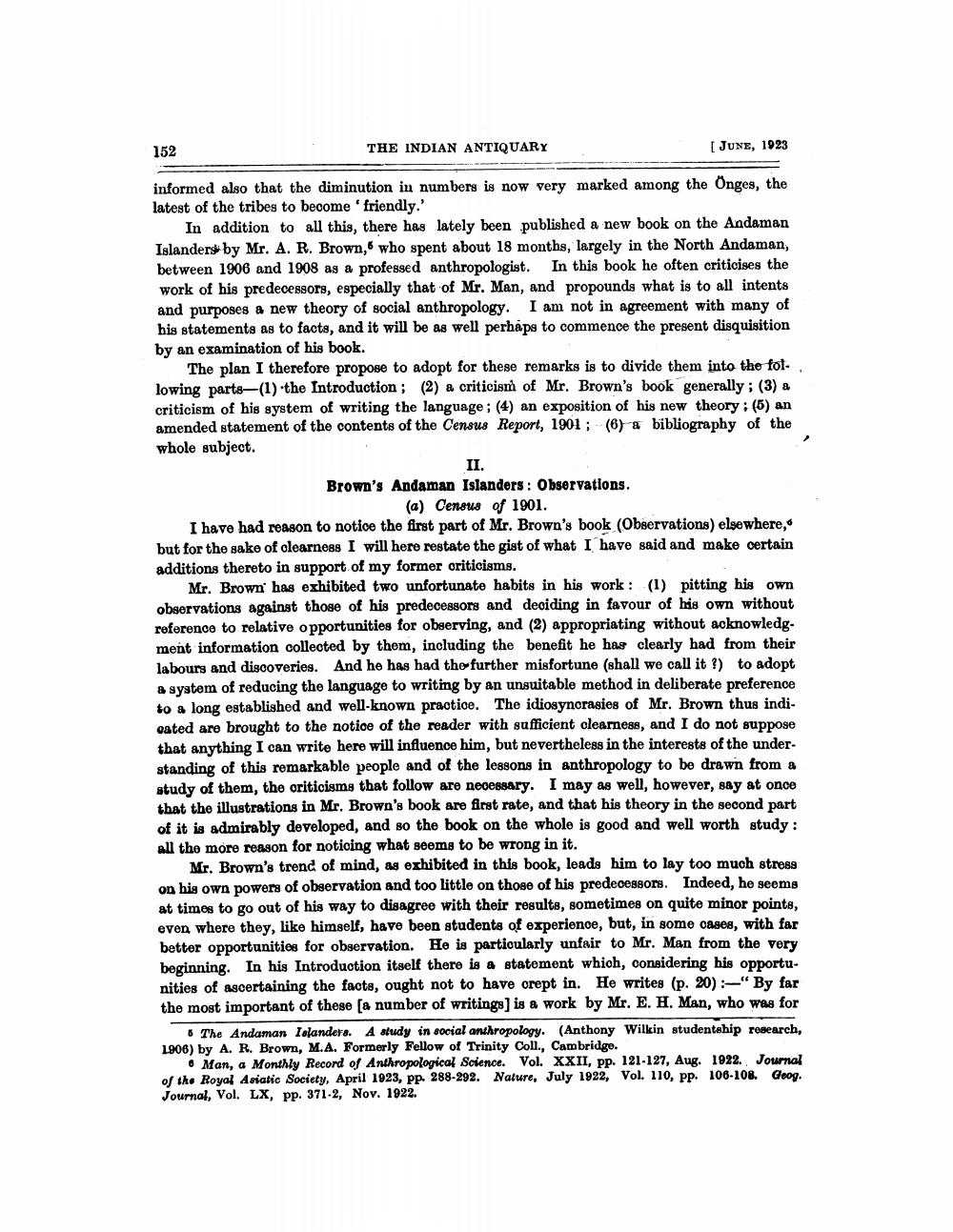________________
152
THE INDIAN ANTIQUARY
[JUNE, 1923
informed also that the diminution in numbers is now very marked among the Onges, the latest of the tribes to beoome 'friendly.'
In addition to all this, there has lately been published a new book on the Andaman Islanders by Mr. A. R. Brown, who spent about 18 months, largely in the North Andaman, between 1906 and 1908 as a professed anthropologist. In this book he often criticises the work of his predecessors, especially that of Mr. Man, and propounds what is to all intents and purposes a new theory of social anthropology. I am not in agreement with many of his statements as to facts, and it will be as well perhaps to commence the present disquisition by an examination of his book.
The plan I therefore propose to adopt for these remarks is to divide them into the following parts-(1)-the Introduction; (2) a criticism of Mr. Brown's book generally(3) a criticism of his system of writing the language; (4) an exposition of his new theory :(5) an amended statement of the contents of the Census Report, 1901; (6) a bibliography of the whole subject.
Brown's Andaman Islanders: Observations.
(a) Census of 1901. I have had reason to notioe the first part of Mr. Brown's book (Observations) elsewhere, but for the sake of olearness I will here restate the gist of what I have said and make certain additions thereto in support of my former criticisms.
Mr. Brown' has exhibited two unfortunate habits in his work : (1) pitting his own observations against those of his predecessors and deciding in favour of his own without reference to relative opportunities for observing, and (2) appropriating without acknowledgment information collected by them, including the benefit he has clearly had from their labours and discoveries. And he has had the further misfortune (shall we call it ?) to adopt a system of reducing the language to writing by an unsuitable method in deliberate preference to a long established and well-known practice. The idiosyncrasies of Mr. Brown thus indioated are brought to the notice of the reader with sufficient clearness, and I do not suppose that anything I can write here will influence him, but nevertheless in the interests of the understanding of this remarkable people and of the lessons in anthropology to be drawn from a study of them, the oriticisms that follow are necessary. I may as well, however, say at once that the illustrations in Mr. Brown's book are first rate, and that his theory in the second part of it is admirably developed, and so the book on the whole is good and well worth study: all the more reason for noticing what seems to be wrong in it.
Mr. Brown's trend of mind, as exhibited in this book, leads him to lay too much stress on his own powers of observation and too little on those of his predecessors. Indeed, he seems at times to go out of his way to disagree with their results, sometimes on quite minor points, even where they, like himself, have been students of experience, but, in some cases, with far better opportunities for observation. He is partioularly unfair to Mr. Man from the very beginning. In his Introduction itself there is a statement which, considering his opportunities of ascertaining the facts, ought not to have crept in. He writes (p. 20)-"By far the most important of these (a number of writings) is a work by Mr. E. H. Man, who was for
The Andaman Islanders. A study in social anthropology. (Anthony Wilkin studentship research, 1906) by A. R. Brown, M.A. Formerly Fellow of Trinity Coll., Cambridge.
• Man, a Monthly Record of Anthropological Science. Vol. XXII, pp. 121-127, Aug. 1922. Journal of the Royal Asiatic Society, April 1923, pp. 288-292. Nature, July 1922, Vol. 110, pp. 106-108. Goog. Journal, Vol. LX, pp. 371-2, Nov. 1922.




